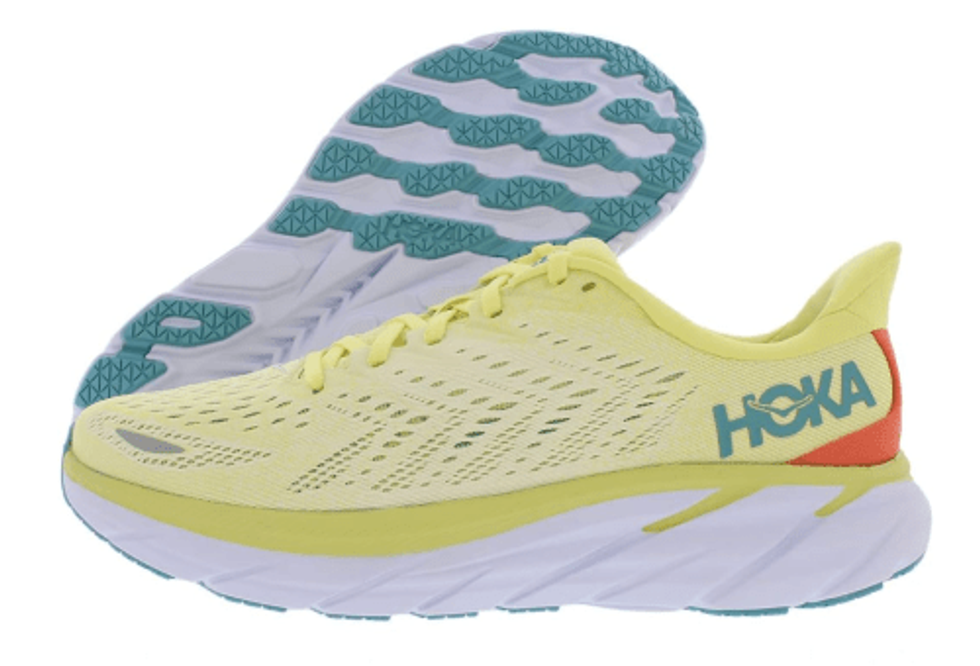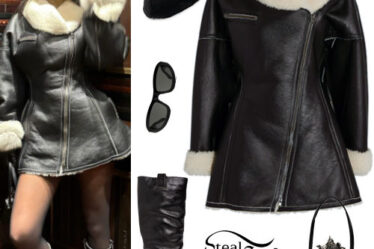
Plantar Fasciitis is a common and gradually worsening foot condition that causes heel pain. Various factors, including your choice of shoes, foot structure, and physical activity, can all trigger its onset and exacerbate its symptoms.
“It is characterized by inflammation and weakening of the plantar fascia, a thick band of tissue that runs along the bottom of the foot, connecting the heel to the metatarsals,” explains Maggie Trevillion, MCPod, MSc, an award-winning podiatrist and founder of Callen Olive. “This inflammation typically causes an aching pain in the heel and or arch, especially with the first steps in the morning or after prolonged periods of rest.”
While there can be many contributing factors, Trevillion notes that regularly wearing the wrong shoes is often to blame. “Approximately 90 percent of the patients I see in my clinic with plantar fasciitis are in footwear which is too small and or lacks support,” she tells Best Life.
Trevillion notes that people with heel pain should prioritize proper arch support, cushioning, and shock absorption in shoes, which can “help distribute pressure evenly across the foot and minimize stress on the inflamed tissue.”
When you try footwear on, your toes should not touch the top of the shoe—there should be at least a one-centimeter gap between your toe and the shoe, Trevillion adds.
Keeping that advice in mind, here are the 12 best shoes for plantar fasciitis.
RELATED: 9 Best Shoes for Back Pain, Podiatrists Say.
Hoka sneakers are popular athletic shoes beloved for their comfort, shock absorption, and style. Trevillion recommends the Hoka One One for people with plantar fasciitis.
“With plush cushioning and a feather-light feel, they’re like walking on clouds. Their meta-rocker technology mimics your natural walking motion, ensuring every step feels effortless. Plus, Hoka offers a wide range of styles and colors to match your unique style, all with a snug fit and durable soles. It’s like giving your feet a warm hug with every stride!” she says, noting that she wears them to work regularly.
 Amazon
Amazon
This shoe will be your best friend on long walks, runs, and more.
“The sneaker provides excellent arch support and cushioning, which is crucial for anyone dealing with heel pain,” says Taher Saifullah, MD, founder of Spine & Pain Institute Los Angeles. “It has a BioMoGo DNA midsole that adapts to your specific stride, weight, and speed, giving you personalized cushioning.”
The shoes also have Brooks’ Extended Progressive Diagonal Rollbar. “That helps control pronation, reducing stress on your heel,” says Saifullah.
A slip-resistant outsole makes it another favorite pick for MDs. It helps ensure stable footing no matter the surface or weather.
 Kuru
Kuru
Kuru is another doctor-approved shoe brand that focuses solely on serving those with plantar fasciitis. Jacob Van Den Meerendonk, DPT, a doctor of physical therapy who goes by Dr. Jacob on social media, shared in a TikTok video that he recommends Kuru’s Atom sneakers and Quantum 2.0’s.
“Especially in the early stages of plantar fasciitis, we want to decrease plantar fascial loading and give the foot the support that it needs to reduce irritation to the bottom of the foot—specifically the heel and the mid-foot arch,” he explains.
“One thing I love about all Kuru shoes is the Kuru sole, which has patented heel-hugging technology in every pair,” he says in the video. “This response technology dynamically flexes with every step you take, giving your heels a little hug—which is exactly what they need.”
Kuru’s Atom sneakers are also available in wide-width and waterproof options.
 Amazon
Amazon
Strive Footwear is a line of orthotic shoes specifically made for people with plantar fasciitis. Trevillion says they’re an “oh so comfy” choice for anyone experiencing the condition or looking to prevent it.
“Strive stands out for its footwear crafted by podiatrists and footwear experts, featuring biomechanical footbed technology,” she explains. “This means your feet, ankles, and legs are properly aligned, reducing strain and promoting a natural walking gait.”
She adds that they’re made from breathable, durable materials that emphasize comfort. “They’ve been my go-to for summer strolls for the past five years!” she says.
 Vionic
Vionic
A slip-on sneaker combines the comfort of kicks with a pumped-up style. These have a breathable (and super pretty!) perforated design.
“Vionic shoes are designed with orthotic insoles that offer excellent arch support and heel cushioning,” says Saifullah. “This one strikes a perfect balance between fashion and function—it has a removable insole, so you can customize it with your own orthotics if needed.”
A few color options are available, including black, slate, white, wheat, and blue, so you can match your shoes to the outfits you wear most.
 Amazon
Amazon
Altra’s sneakers have a wide toe box, great arch support, and ample cushioning, making the brand perfect for those with plantar fasciitis.
This shoe comes in several colors and has a fun ombre effect. (It’s also available in basic white and black if you prefer something more versatile.)
“It has an adequate cushion to help relieve heel pain and a 4-millimeter drop where the heel is slightly higher than the toe to allow forward roll, which can take pressure off your Achilles and heel area,” explains Milica McDowell, doctor of physical therapy and VP of operations at Gait Happens.
“It has a roomy toe box to prevent your toes from getting cramped and squished, and its flexible sole allows for better use of foot muscles and less reliance on hard impact on the heel,” adds McDowell.
 Amazon
Amazon
Merrell is another brand that’s trusted by podiatrists and is ideal for people with plantar fasciitis. Their Bravada Breeze Hiking Shoes are a particularly popular pick.
“Merrell shoes are the epitome of reliability, versatility, and style. Crafted with premium materials and built to last, they’re perfect for any adventure,” Trevillion says. “Their cushioned footbeds and supportive midsoles ensure all-day comfort, whether you’re hiking trails or pounding pavements.”
The podiatrist adds that she personally loves Merrell for their unbeatable combination of quality, comfort, and fashion-forward designs, which she says make them “perfect for rambling and everyday wear.”
 Amazon
Amazon
Christopher Reeves, MD, a board-certified podiatric foot and ankle surgeon in Central Florida, suggests this brand for people who want something style-forward.
“When dealing with true heel pain, it’s important to consider prioritizing support and comfort over fashion,” he says. “However, the On Cloud brand does a commendable job in this department.”
The shoe is available in more than a dozen colors and does an excellent job supporting your heel and arch. “I wore them the first day for an 8 hour shift where I was constantly on my feet and walking over 10,000 steps. I never once got any blisters and they felt so comfortable,” wrote one reviewer on Amazon.
Plus, there are no shoelaces to tie, so you have one less task to complete on busy mornings.
RELATED: The 7 Best Walking Shoe Brands.
 Nike
Nike
This sporty shoe is the ideal blend of chunky and streamlined.
“It’s a fashion sneaker with a functional heart, and it’s amazing for those with heel pain because it has cushion, a higher heel area to provide support, and also an increased foam midsole to take pressure off your arch,” says McDowell.
 Anya’s Shop
Anya’s Shop
The lace-up front on this ankle boot allows you to choose as much or as little support as you’d like, which can help with heel pain and stability.
“The nearly flat, or low drop, sole helps to allow footless stress more than a higher-heeled boot, and if you are struggling with heel pain, a chunky or higher-heeled boot will only make your problems worse,” explains McDowell.
These sneakers will be comfy for long walks, even if they’re on uneven terrain.
“This boot also has a functional shape—the sole of the boot looks like a foot, not like an arrow—which means your toes can splay, allowing the muscles to work optimally,” McDowell points out.
 Vionic
Vionic
If you suffer from plantar fasciitis and need a sandal you can walk around in, look to Vionic.
“This brand is my go-to,” says Kristian Jeffress, MD, a podiatrist at Affinity Foot and Ankle. “They are one of the few sandals that have a built-in arch that provides support for prolonged walking and standing while keeping your feet cool on these hot summer days.”
This sandal has a supportive ankle strap and a comfy, lightweight lug sole. Plus, it comes in a simple, modern shape that’s super on-trend.
Don’t forget about inserts and indoor footwear.

Even if you opt for shoes specifically recommended for plantar fasciitis, you can increase their therapeutic effects with the help of orthotic inserts.
“Custom or over-the-counter orthotic inserts can provide additional support and cushioning, correcting any biomechanical issues that may contribute to plantar fasciitis,” says Trevillion.
Lori Grant, DPM, a podiatrist at Orlando Health, also recommends trying heel cups, which add cushioning under the heel for added comfort and support.
Investing in a supportive pair of slippers or indoor-only sneakers can also help improve your symptoms of plantar fasciitis.
“Walking barefoot or on hard surfaces can exacerbate symptoms, so wearing supportive footwear, even at home, is advisable,” says Trevillion.
RELATED: The 7 Best Walking Shoe Brands.
Other ways to improve symptoms of plantar fasciitis.

In addition to choosing the right shoes and inserts, there are several other ways to improve your symptoms of plantar fasciitis.
The first that Trevillion recommends is regularly stretching and strengthening the calf muscles and the plantar fascia, which she says can help reduce tension and improve flexibility, easing pain and discomfort. Your podiatrist or physical therapist can help guide you when you’re first getting started.
Applying ice packs can help reduce inflammation and relieve pain, offering short-term relief to your plantar fasciitis symptoms.
Grant recommends filling a plastic water bottle and freezing the contents. Then, roll the foot on the frozen water bottle, applying gentle pressure to massage the affected area.
A night splint—a soft boot that holds the foot in a therapeutic position while you sleep—may also be beneficial if you suffer from plantar fasciitis.
“Wearing a night splint can help maintain a gentle stretch on the plantar fascia and Achilles tendon while sleeping, which aids to significantly reduce morning pain or getting up to the restroom during the night,” says Trevillion.
Additionally, “Maintaining a healthy weight can reduce pressure on the feet and alleviate symptoms of plantar fasciitis,” Trevillion notes.
In fact, having a body mass index (BMI) of 30 or above can increase your risk of developing plantar fasciitis by up to six times, some podiatry groups say.
If you’re still suffering, your podiatrist may also be able to recommend certain in-office treatments to help alleviate your symptoms.
Trevillion says she’s a “major fan” of extracorporeal shock wave therapy, which uses either focused shockwaves or radial pressure waves to accelerate recovery. Besides plantar fasciitis, this outpatient procedure is often used to treat chronic tendonitis, Achilles tendonitis, and other conditions affecting the tendons and joints.
“It’s quick, safe, and non-invasive, with an 80 percent success rate. It accelerates healing and reduces downtime,” the podiatrist says.



